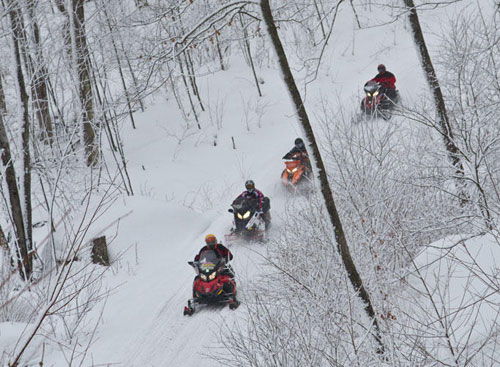
Keeping your snowmobile up and running not only protects your investment in the machine, but also keeps you and your family safe. If your snowmobile breaks down in the middle of winter, you might find yourself stranded in the cold. Snowmobile maintenance ranges from basic inspections to tweaking the tuning. Here are seven things you should stay on top of to make sure that your snowmobile doesn’t get stuck in the snow.
Check Your Trailer
The wiring harnesses, wheel bearings, and tires on your trailer should all be inspected on a regular basis. If the trailer has been backed into water over the summer, you should re-grease your wheel bearings and check the tire pressure. Having a trailer that is in good working form will protect your snowmobile from being stuck on the side of the road while they’re in transit.

Inspect the Brakes
The brake system is one of the most important safety features of your snowmobile. Always start your snowmobile season by checking the brake pads, slide-rails, carbide runners, and studs – and replace them as necessary. The bearings and the wheels on the suspension may also need to be checked. Having a safe vehicle can often get you a better insurance rate through a specialist insurance broker.
Clean the Carburetors
Corrosion can build up in your snowmobile’s carburetor, so you should always remove and clean the carburetor. When a carburetor is dirty, the fuel flow can be slower.
Assess the Track
You should also inspect the track on the snowmobile to make sure that it’s not coming apart and the studs are not penetrating a coolant tank or the fuel tank. You can run the snowmobile in place for a few minutes to see if a leak appears.
Consider Gas Quality
High octane gas is best for snowmobiles. Get your gas from a high traffic station, which will have new gas available – this ensures that you will get the high octane gas sold in the winter when you fuel up, and not older fuel still being sold from the summer blend. The right gas can help your snowmobile run more consistently and keep the system clean.
Adjust the Tuning
When you tune or “jet” a carburetor, you are fine tuning the main circuits to better gas delivery and improve the overall engine performance. Along with cleaning the carburetor, you should adjust it as needed depending on the temperature. In warmer temperatures, the snowmobile should generally be jetted down, and when it gets cold you can jet it back up a few sizes.
Gut the Air Box
When you gut the air box, you may be able to improve the air flow and make the machine quieter. Just be sure to re-jet if necessary to avoid damaging your snowmobile’s engine.
Proper maintenance on your snowmobile is absolutely necessary to keep it on track and out of the shop. By tuning your engine, providing it with the best quality gasoline, and always looking for coolant leaks – you’re starting your sled off on the right foot each season.
George Nesler has owned and operated a snowmobile for many years now. He likes to unwind by posting his insights on various Internet blogs.














